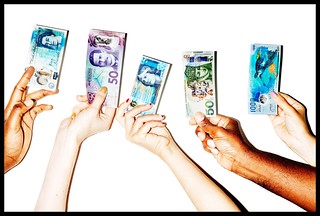
PREV ARTICLE
NEXT ARTICLE
FULL ISSUE
PREV FULL ISSUE
2016 BANKNOTE OF THE YEAR NOMINEESMeanwhile, Bloomberg Businessweek published a nice article December 1, 2016 about the International Bank Note Society and their Bank Note of the Year award. -Editor
Then, in 2005, the IBNS made an announcement: Its members had chosen the first annual “Bank Note of the Year.” All bills introduced into general circulation the preceding year had been eligible; voters were instructed to choose the one with the best combination of artistry and security. The IBNS may have been tiny, but it knew how to stoke rivalry among the world’s mints. The news release crowning the winner, a Canadian $20 bill with a sublime portrait of Queen Elizabeth II, said it had “only just beat the new Faeroese 200-krone bank note,” which featured “a Ghost Moth printed in intaglio amongst blades of grass.” An obscure global tournament was born. The Faeroe Islands avenged the loss the next year, and subsequent winners have included Bermuda, for a $2 bill with anticounterfeit features that belie its low face value, and the Comoros, for a 1,000-franc note bearing poetry. (“From our feelings, what you expect I understood / For it is a love that is so absolutely exclusive / That, not to lose you, I hereby consent.”) Kazakhstan reeled off a three-peat from 2011 to 2013. The U.S.’s staid greenbacks have never won. As the competition has gained more attention, IBNS President Dennis Lutz says proud governments have begun to get in touch, trying to handicap the chances of their new Maldivian rufiyaa and Macanese pataca. IBNS members are about to vote for the best bill of 2016. Among the nominees—see the following—are entries from England, Switzerland, and Georgia, whose 50-lari note is full of medieval iconography. Lutz won’t tip his hand, but he says patterns do emerge among admirers of paper (and, now, polymer-based) currency. “I have to say, right now people are really going for color,” he says. “And they like things like flowers and birds. Not people.” While the print version of the magazine has only the generic graphic of people holding various notes, the online version has full images of the nominees. Here are a few that caught
my eye. Can you tell my favorite colors? Or are these just the "in" colors this year? See the online article for the rest. -Editor
England 5 pound 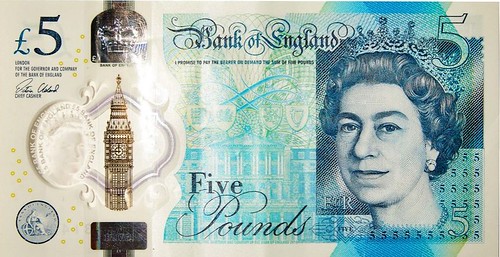 The Bank of England’s first polymer note entered circulation in September. Bank Governor Mark Carney took one to a food market to dip in a vat of curry, demonstrating it was waterproof. The food-related stunt proved inauspicious when the bank acknowledged the bills were made with trace amounts of animal fat. A Change.org petition to ban the component received more than 52,000 signatures within 24 hours. See an article elsewhere in this issue about the animal fat issue.
Scotland 5 pound 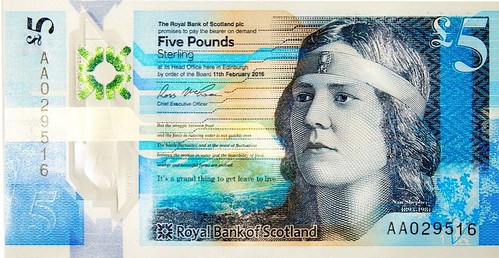 Scotland mints bills that are accepted widely across the U.K. After a series of polls and focus groups, the country chose the theme “the fabric of nature” for its new £5 and £10 notes. The fiver features the writer Nan Shepherd (1893-1981), best-known for her book The Living Mountain. Um, not quite true. People constantly report problems with the acceptance of Scottish notes in England. They're legal tender, but often refused.
Maldives 1,000 rufiyaa 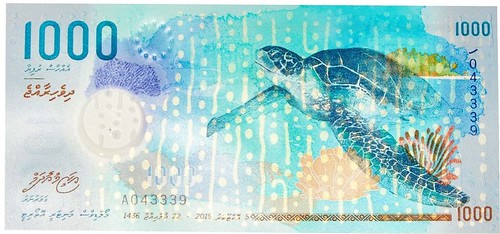 Its theme is “the beauty in our surrounding.” The primary side depicts a whale shark, with an underprint that gives shading to its skin; on the obverse is a green turtle. Yeah, I know - banknote sides are properly called "face" and "back", and even so, "obverse" is the PRIMARY side (of a coin). Oh, well. I'm just
delighted to see this in a mainstream publication.
To read the complete article, see: 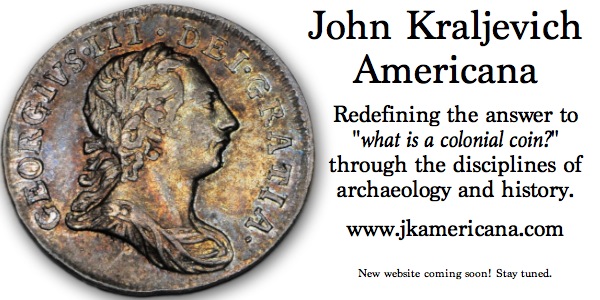 Wayne Homren, Editor The Numismatic Bibliomania Society is a non-profit organization promoting numismatic literature. See our web site at coinbooks.org. To submit items for publication in The E-Sylum, write to the Editor at this address: whomren@gmail.com To subscribe go to: https://my.binhost.com/lists/listinfo/esylum All Rights Reserved. NBS Home Page Contact the NBS webmaster 
|
